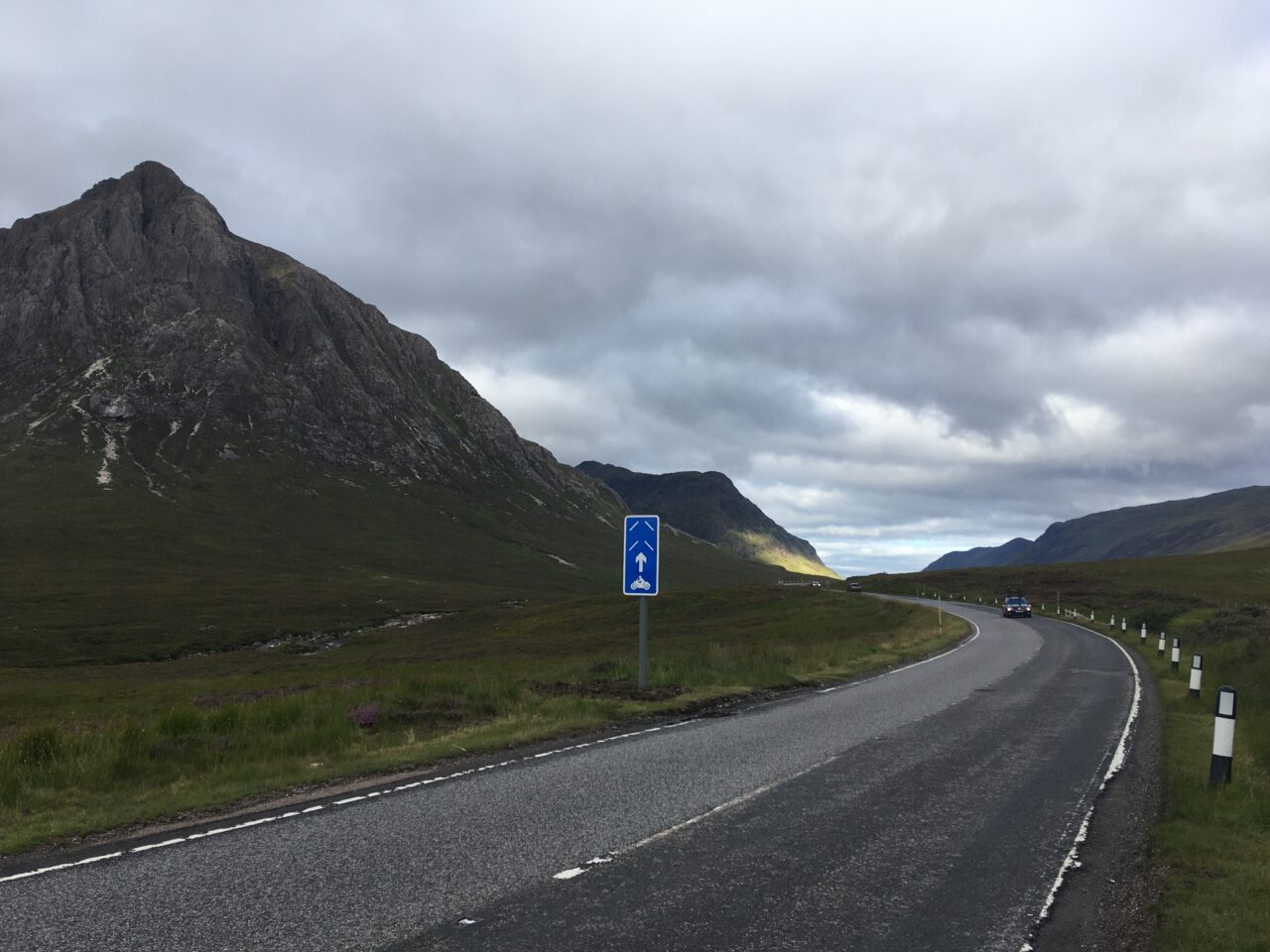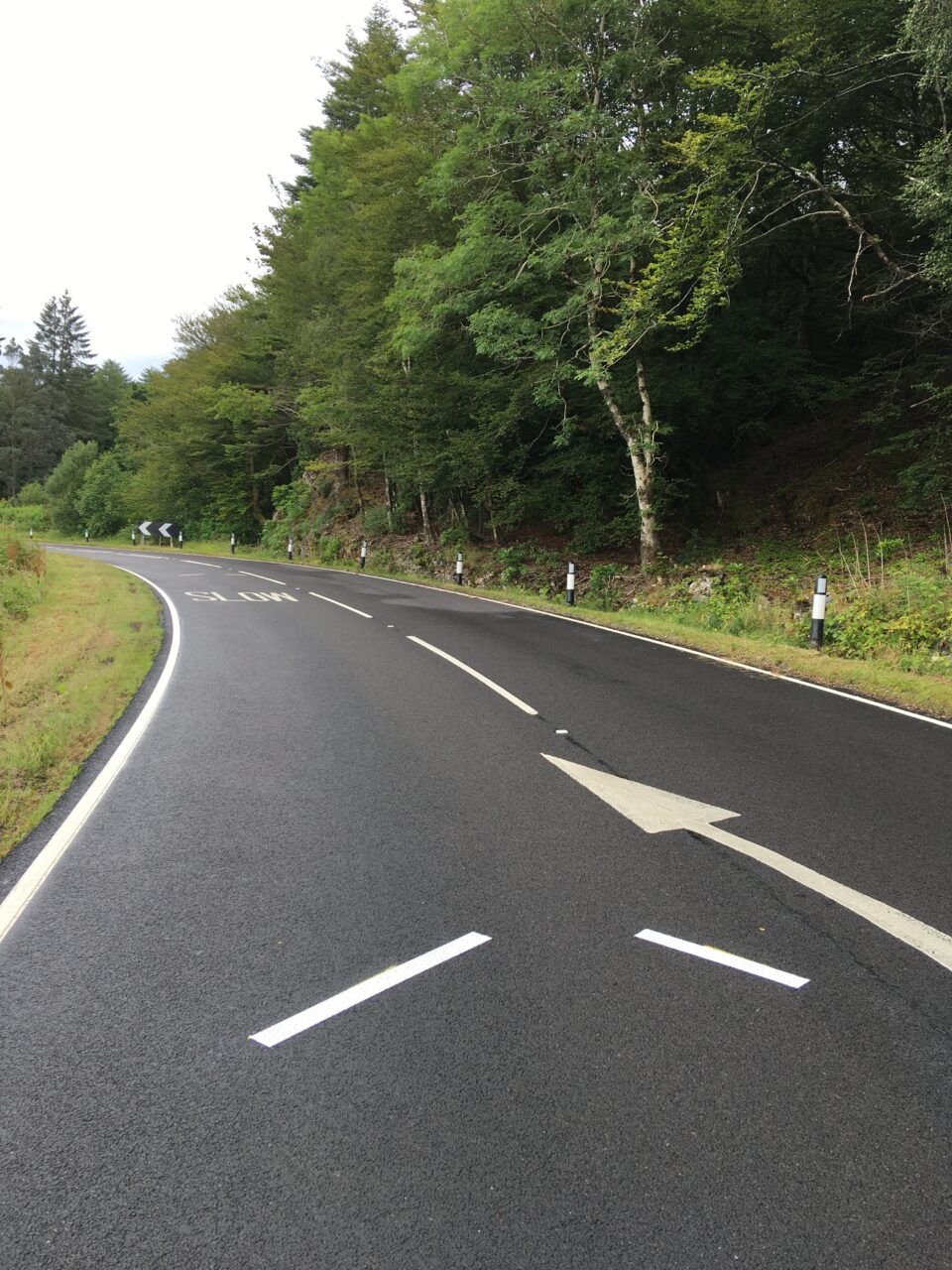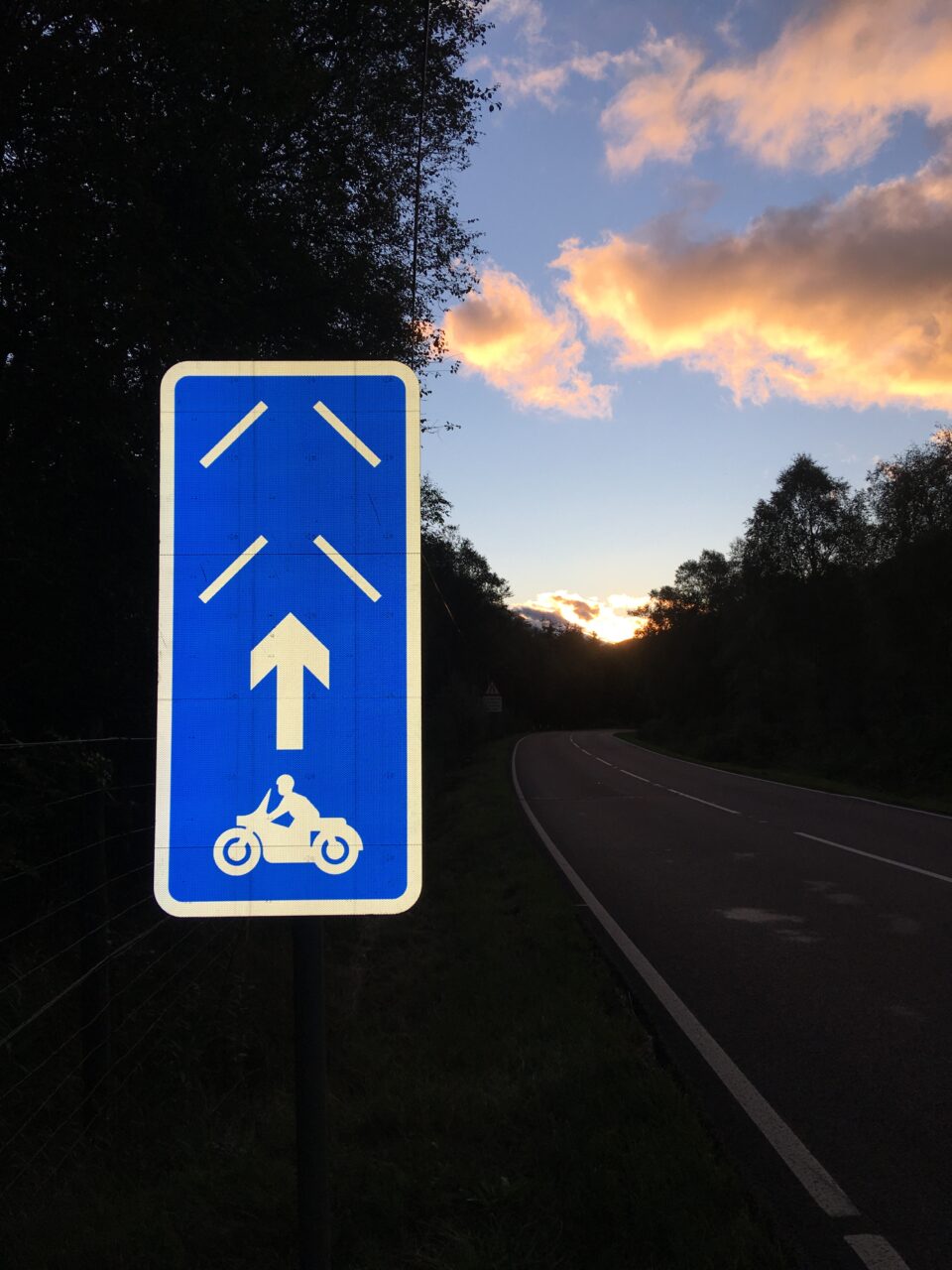Welcome to the fifth instalment in our safety feature campaign series: Devitt Rider Safety with road safety journalist @djrwilliams.
We’re on a mission to create heightened awareness and debate around vital rider safety topics, initiatives and campaigns. Riders love to talk about all the latest safety and riding skills and here, at Devitt, we aim to be at the very forefront of that discussion.
Join the debate today on social media at #DevittRiderSafety
THE story behind mystery road signs and markings that appeared alongside some of Scotland’s best biking routes – and that have been intriguing motorcyclists over the past year – has been revealed by research scientists.
It turns out that the features – on roadside poles and on the road surface – are part of a trailblazing new experiment into motorcycle casualty reduction, launched by Transport Scotland.
The eye-catching new ‘user information’ – devised by a research team including road safety specialists at Open Road Simulation Limited (ORS) – uses ‘applied’ or ‘nudge’ psychology to influence bikers on their choice of speed, positioning and braking as they approach challenging bends.
So far the signs and markings, dubbed PRIMEs, or ‘Perceptual Rider Information to Maximise Expertise/Enjoyment’, have appeared at four sites on three different roads frequently singled out by riders seeking a mix of challenging bends, fast straights – and stunning scenery.

Located on the A828 A82 and A85 – roads linking famous West Highlands beauty spots including Glencoe, Fort William and Oban – they first appeared in 2020 and will continue to be trialled until 2022 thanks to funding from the Road Safety Trust to extend the research. If – as scientists hope – they have a marked effect on rider behaviour, the radical new approach could be rolled out across other challenging locations.
Something new – and secret
So what’s the big idea? Professor Alex Stedmon of ORS, says motorcyclists are often ‘difficult to reach and engage with’ on matters of road safety. In addition, they tend to adapt to conventional road safety messages so that their effect wears off over time. “We wanted to try something new and engaging,” says Prof Stedmon, (the world’s first Professor of Motorcycling).
Intriguingly, the precise way in which these radical new PRIMEs influence riders can’t be revealed – in case it affects the scientific trials and research data. What scientists will reveal, however, is that the mystery PRIMEs consist of upright sign posts at the roadside, and markings painted directly on the road surface, on the approach to bends, to ‘prime’ riders’ behaviour.
The blue roadside signs display an image of a motorcycle, above which is an arrow pointing in the direction of travel. Above that are short, slanting white lines. The white lines are repeated at set intervals on the approach to the bends on the actual road surface.

The bends were chosen for a variety of reasons; they’re technically demanding because of factors including limited vision, offset cambers, damp surfaces, walls running alongside, tricky lighting conditions, and unpredictable geometry.
Encouraging results
The results of the experiment have been encouraging, say researchers. Using on-site cameras, almost 13,000 motorcyclists were analysed last summer. Around a third of these were analysed in more detail.
After studying the data, it became apparent that riders are changing their speed and positioning on approach to a number of bends, potentially making them safer. And all without any explicit instructions or nagging. The effect of PRIMEs on braking was less evident. Crucially, there was no evidence of any negative effects on rider behaviour.
Overall, says Professor Stedmon, there’s ‘strong evidence for a range of beneficial effects’. In other words, PRIMEs are helping riders judge speed, position and braking, in ways that are yet to be explained.
Professor Stedmon reveals that of the 13,000 riders, approximately 10 per cent were carrying a pillion and around two-thirds of riders were part of a larger group, highlighting the sociable nature of motorcycling. Which is why many of us ride in the first place.
New skills
The ultimate goal, says Professor Stedmon, is to reduce casualties, develop a new approach to road safety and devise guidelines for installing PRIMEs in additional locations. “Our aim is that PRIMEs are intuitive and require little thought,” says Professor Stedmon. “Anything that a motorcyclist has to think about too deeply could affect their riding.”
If the scheme is rolled out further afield, it can’t come soon enough. In Scotland, motorcyclists make up just 2.2 per cent of road users but are involved in 14 per cent of what experts call ‘KSIs’ – ‘killed and seriously injured’ figures. UK-wide, motorcyclists typically represent less than one per cent of the total vehicle miles on roads but account for 21 per cent of all road fatalities and are around 51 times more likely to be killed than car drivers.

Expert research shows that rider error is often the cause for loss of control on bends due to ‘inappropriate’ speed, poor positioning and failing to steer correctly. There can’t be a single rider who hasn’t – on occasion – tensed up, or worse, after misjudging a bend and going in a little (or a lot) too fast…
The PRIMEs research is the biggest scheme of its type ever tackled in Scotland and possibly the UK. Watch this space to discover what happens next – and whether the ‘mystery’ markings will be coming to a bend near you, any time soon.
WHY DO RIDERS HAVE ACCIDENTS ON BENDS?
Some of the dangers – including restricted vision, slippery surfaces and inexperience – are obvious. Experts say that accidents more likely happen on sharp bends rather than on gentle bends and that left-hand bends are more dangerous for those riding on the left-hand side of the road. That’s because it’s harder to gauge the bend’s curvature when riding on the inside ‘lane’ of a bend. Other challenges include problems with judging correct ‘vanishing points’ and difficulties with identifying safe braking distances.
As experienced riders know, in order to safely ride round a bend you have to be at a suitable speed for the conditions, your lane position has to be correct on entering the bend, and you have to have slowed down enough first – so you don’t need to brake while going around the bend. But it’s trickier than it sounds, especially for novices.
WHAT’S WRONG WITH EXISTING ROAD SIGNS?
Their effect can ‘wear off’ through familiarity. Current road signs are also generic; they tend to apply to all types of transport. PRIMEs are designed specifically for motorcyclists by motorcyclists, based on research into the unique needs and requirements riders have when approaching demanding bends.
The mystery of the PRIMEs signs was revealed at Road Safety GB’s online PTW event, ‘PTW Riders: improving safety and reducing collisions and casualties’, sponsored by Devitt.
David Williams is a freelance journalist who specialises in road safety, transport and travel. He’s been the London Evening Standard’s motoring correspondent for 26 years, also contributing to the Daily and Sunday Telegraph, Sunday Times and various magazines. He is a Prince Michael of Kent International Road Safety Awards judge.

14 comments on “Scientists reveal the reason for ‘Mystery Biker Road Signs’”
After 52 years of riding throughout the world I really think thick white paint on wet roads approaching bends would have helped me avoid the zero accidents I had which were my fault.
Your comment made me smile Paul. There is no real reason, why a shell grip type surface could not be used, IF they think these signs can be proven to be useful. 54 years of riding.
Lovely slippery lines, great ! Of course if you go through the target you will be in the perfect position to navigate the core et perfectly – according to who? Oh and Bravia’s r you are fixated on missing the white lines you will not be looking through the corner so will miss the apex and exit !
There is absolutely nothing that would assist riders to understand the seriousness of any bend at all…….. other than what we already see, signage. chevrons, warnings, SLOW painted on roads. recommended speed signage, hazard lines and solid white lines and shellgrip are all indications of a bend ahead. Many bends have these warnings due to the history of incidents and indeed many riders don’t take much if any notice of them at all.
It was stated in this article that one shouldn’t make things too difficult for motorcyclists as they don’t have the brain power to understand something that is too complicated?. So why not get rid of all those signs and ease their mental burden.
If one simple sign says it all and that sign is tuned into the mind of drivers and in particular motorcyclists then they will be worth it but I doubt that this will ever be the case. That said I am sure that someone will see fit to justify these new experimental signs as few would want to admit that they don’t work. They will become the new ’20 is plenty scheme’ signage that re being introduced all over the place nowadays.
If however we just have ONE generic sign posted for a bend that needs it due to history and then instead of the bend sign showing one degree of curvature perhaps a bend signs that actually depict or indicates the degree of severity of any bend. Instead of the usual ONE a bend sign that would signify that the bend is say a 90 deg. one or one of more than 90 deg. or less ie only 20 deg. Riders seeing just how severe the bend is would or should ride it accordingly as one has informed them and made them think of how to take it in the first place.
Or as an alternative perhaps under a single warning of a bend ahead, add a further indication of its severity. Something in black and yellow, the same colours of a number plate and already in use on chevrons but with signage, the same size as a number plate. On it a number of black chevrons, one to 4 chevrons black coloured on a yellow background , indicating the severity of that bend or series of bends. 1 chevron would be a minor bend up to say 20 deg. The numbers of chevrons then increasing to four depending on the serious nature of the bend. So a 90 deg would be 3 chevrons and a 4 chevron bend would indicate a returning bend and or one with a reducing radius the severest bend that one would ride round.
These 1 to 4 chevrons would also be duplicated by the actual siting of chevrons as seen on approach to a bend and throughout it. Indicating once again the bends severity. So any one, a car driver or a motorcyclist could easily see that the bend ahead is a shallow one, having a single chevron but more chevrons depicting a more serious bend, one where some greater degree of slowing and braking and the changing of gears would be required in order to navigate it with safety.
I’ve come across this article because I was trying to find a BMF News item from December 2019.
I can see where the thinking for the signs comes from. First the road sign encourages bikers to ride between the 2 slanted white painted stripes (who would by choice ride over white paint on a bend?). Secondly on the road the paint is so positioned to encourage the rider to follow the System as set out in Motorcycle Roadcraft to position towards the outside of the bend to gain better/advanced visibility around the bend. I see this as a win-win, as long as the gaps between the two diagonal strips isn’t seen as being too small. Also as cars will have to drive over the white paint, it had better had as good a grip to it else cars will become unstable if on a bend in the wet (or as this is in Scotland the ice & snow).
I’ve only recently seen the signs from a four wheeled vehicle and came here to find out what they meant. Not been on the bike on those roads in a while and would not have noticed had I been riding. I done police roadcraft training many years ago and that knowledge has kept me accident free all my riding life of over forty years. I just don’t see how this experiment will work if riders don’t know what the signs mean. There is just nothing that says slow down. For me, no matter what I’m driving I treat bends as I find them. If I can’t see around I approach at a slower speed that if it was a well used sweeper with visibility around it.
On every dangerous bend just put a skull and crossbones with a number under it followed by, “And Counting”. It would be self-explanatory.
Saw these when they first came out – sussed pretty quickly what they were for and then enjoyed playing with them. I think they’re a great idea. Some good research behind them too – from NZ or Australia? Anyhoo…very useful for a corner you’ve not done before, IMHO.
Painting lines on roads prior to bends is not the best idea for motorcycles when wet. Riders can already slip crossing these lines which sit proud of the road surface. Not a great idea, of course as all ready suggested road signs in yellow back ground and black letters and figures informing the angle of bend is simple as long as they as far enough ahead of the bend and unobstructed . This is already in operation in the South of Ireland and works for motorcycles and other vehicles as no one is going to speed around a depicted severe angled bend intentionally.
Money talks and those in receipt of it need to produce something they just like gov figures can always produce what is needed to get a point across. Cannot in all honesty say these signs and painting white lines on rider line for any corner is a good idea.
I think you have made some very good points in your comments. It whould be good to see these signs ect around other parts of the country I live in devon . And I am often on the back of my brothes bike when he comes to stay . I quit often have to ⚠️ him about some of the bends that are very sharp and drop down steeply . The sings whould save other rides lifes on these bends as they are a lot of bikes accidents on them
If this saves a bikers life then I’m all for it. I’d suggest doing the iAm though & learning to ride to a higher’ safer level.
It seems a fairly good idea. Intuitive and I’d like to trial them myself. Anything that helps is good, without patronising. At least someone is thinking of us, and wants us to keep enjoying the roads.
I’ve only been riding motorcycles for 44 yrs and don’t know everything
White lines, that get slippery when the roads are wet. What could possibly go wrong?
Well just 1 life saved is a good thing.
1 serious injury prevented is a good thing.
But, the first time I came across these markings I found them a distraction.
They seemed to in still an element of doubt and had an adverse effect on the rhythm and flow of my ride.
I soon learnt to ignore them.
In spite of their negative influence on an already successful riding style of 47 years, I hope they help at least 1 person.
Scientists be aware, the road is not the right place to play mind games on motorists., especially when they may generate an unanticipated rider reaction that any following road used may not anticipate.
Stopping a rider from assessing and thinking ahead for them self, will/may generate a negative result. It stops learning.